Double white lines are used to inform drivers of a hazard and where a continuous solid white line is present, prohibit drivers from overtaking as it is too hazardous to do so.
Double white lines also to separate opposing traffic flows on steep hills with climbing lanes. Double white continuous lines can also occasionally be used on single carriageway roads to divide lanes traveling in one direction.
A driving test can easily be failed by incorrectly following the rules of double white lines on the road. Furthermore, the law is strict in these circumstances and can result in penalty points of a full or provisional drivers licence and a fine.
Crossing double white lines
It is illegal to cross a continuous solid white line if the solid line is on your side of the road, except under certain conditions.
You are permitted to straddle or cross a continuous solid white line to enter a side road or property, to manoeuvre round a stationary vehicle blocking your side of the road, to overtake a cyclists, horse or a road works vehicle moving at 10 mph (16 km/h) or less. Crossing double white lines where the line closest to you is solid is illegal outside of the circumstances described above.
If the line closest to you is broken, you are permitted to cross this line providing it is safe to do so and that the overtaking manoeuvre can be completed before reaching a solid white line on our side of the road. Stopping on a road that has double white lines regardless of solid or broken on your side of the road is prohibited except to stop to pick up or unload passengers.
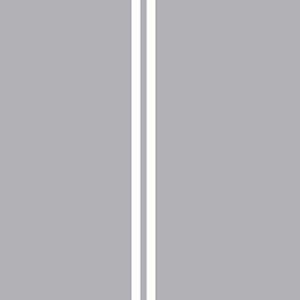
Fines for crossing double white line
The fine for crossing double white lines where the line nearest to you is solid often results in a driving conviction code TS50 – Failing to comply with traffic sign (excluding ‘stop’ signs, traffic lights or double white lines – resulting in 3 penalty points and a £60 fine.
Double white lines where both lines are solid
Solid white lines on both sides means traffic in either lane must not cross lines except for the above circumstances.
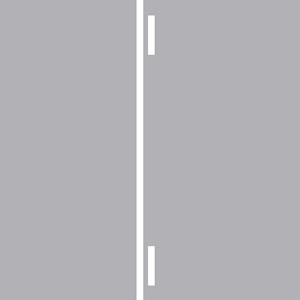
Double white lines where the line nearest you is solid
Solid white line on your side of the road means you must not cross the line except for the above circumstances. Vehicles in the opposite lane may cross the line.
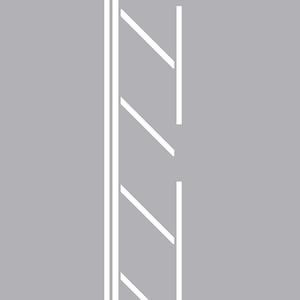
Hatched markings where the line nearest you is solid
Some double continuous white lines have narrow areas of hatched lines within them or a wider area of hatching to the side. You must not cross a continuous white line to enter a hatched area.
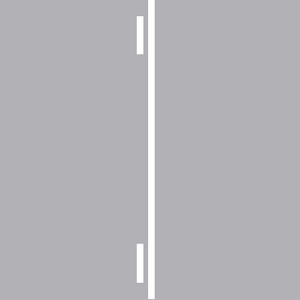
Double white lines where the line nearest to you is broken
This means you may cross the lines to overtake if it is safe, provided you can complete the manoeuvre before reaching a solid white line on your side. White direction arrows on the road indicate that you need to get back onto your side of the road.
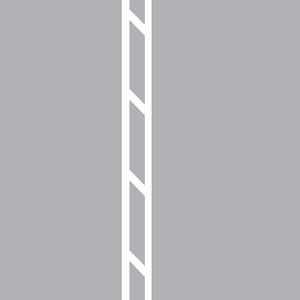
Hatched markings where both lines are solid
Hatched area to increase distance from lanes surrounded by solid double white lines. Traffic either side must not cross into hatched area.
Parking where double white lines are in the centre of the road
It may seem perfectly reasonable to park on a road with double white lines in the middle, especially if the line on your side, or the side that you intend to park is broken. However, the Highway Code (rule 240) states that you must not park on a road marked with double white lines, even when a broken white line is on your side of the road, except to pick up or set down passengers, or to load or unload goods. Note; the wording ‘must not’ is stating a mandatory action, whereas ‘should not’ advises only.
RELATED Tutorials on Road Markings
- See road markings and lines for further guides on road markings and their meanings

I wasbehind a farm tractor that was traveling under 10 mph on double white lines & there was no sign of any entrance or gateway ahead although there was a hump 600 metres ahead it was clear to see the road ahead for the next quarter of a mile was clear & well safe at this point to overtake which not only me but several cars behind me also overtook the tractor, My grandson whom had recently passed his test told me that what I had done was a traffic offence & that he had been taught by the professional driving instructor that you mus never on any circumstances overtake on a double white line, I replied that is correct unless there were certain circumstances like very slow moving transport, such as , horse, cyclist an accident, slow agricultral vehicles & providing it is clearly safe to do, The reply was: That I was talking complete rubbish & that I know nothing & he had recently passed his driving test therefore he would know better than me. As a truck driver for forty years Do I know the highway code ? Or am I talking complete rubbish and know nothing ?.
Technically he is correct. The Highway Code states:
Rule 129
Double white lines where the line nearest you is solid. This means you MUST NOT cross or straddle it unless it is safe and you need to enter adjoining premises or a side road. You may cross the line if necessary, provided the road is clear, to pass a stationary vehicle, or overtake a pedal cycle, horse or road maintenance vehicle, if they are travelling at 10 mph (16 km/h) or less.
As you can see, there’s no mention of agricultural vehicles. Further, scroll down to No stopping or crossing white line marking, 9(5) The Traffic Signs Regulations and General Directions 2016 – again, no mention of agricultural vehicle.
Having said that, the tractor driver is under legal obligation to ensure they do not hold up a long queue of traffic (Rule 169). The driver should pull over when a queue of around 6 or more vehicles form behind (providing a suitable place to pull over occurs of course). The driver could face a charge of inconsiderate driving if they fail to do so.
Can I park on the side of a road with double lines in the middle if I am right off the road? I mean with no part of the car or trailer actually on the road, in fact at least 1 meter off the edge of the roadway?
Hello Inge,
The solid double white line road marking is prescribed for use by local traffic authorities in the Traffic Signs Regulations and General Directions 2016, as amended, (TSRGD). TSRGD stipulates that a driver should not cross the solid white lines and this relates to when the driver is currently on the road where this road marking is sited.
Rule 240 of the Highway Code states that drivers ‘must not stop or park on a road marked with double white lines, even when a broken white line is on your side of the road, except to pick up or set down passengers, or to load or unload goods.’ However the restriction on stopping does not apply if there is more than one traffic lane in each direction and as such a separate Traffic Regulation Order would be required to prevent waiting or loading on these roads.
Therefore, there is no such prohibition for parking off the carriageway that has double white lines, unless specific signage is in place (outside of London).
It would be interesting to see the Words in bold WHAT YOU MUST NOT DO & then the same picture format above BUT … with the same type Picture format with the words WHAT YOU CAN DO … If considered by guidance within the Highway Code Rules as ‘ SAFE’ to do so
eg showing the White line markings in instances of what the everyday Good Driver MAY CONSIDER or CAN DO … or what would be considered within the Rules of the Highway Code as acceptable again providing it is deemed ‘SAFE’ to do so. POSITIVE Guidance as opposed to Less Positive / Confusing Guidance !!!!
Hello Chris O
Under the heading ‘CROSSING DOUBLE WHITE LINES’, in terms of solid and broken white lines it explains quite clearly what you are permitted to do along with anything outside of those circumstances being illegal.
In terms of positive guidance, it’s something that driving instructors use when teaching, but when it comes to the law, you need to be explicit in stating something that you must not do, just as the Highway Code does.
Worth noting that the use of double white lines stated here applies to a single carriageway with lanes on either side of the double white lines having opposing directions of traffic.
Double white lines seem to be occasionally used on motorways, dual carriageways or in tunnels to attempt to restrict traffic from changing lanes. There does not seem to be any basis in law for this as Regulation 26 (2) (b) of the Traffic Signs Regulations and General Directions 2002 states “every vehicle proceeding on any length of road along which the marking has been so placed that, as viewed in the direction of travel of the vehicle, a continuous line is on the left of a broken line or of another continuous line, shall be so driven as to keep the first-mentioned continuous line on the right hand or off side of the vehicle”
This would lead to the patently absurd situation that only the lanes left of the double white line could be used on the motorway or tunnel, even though all traffic is travelling in the same direction. As such, these particular brand of double white lines appear to have no defined basis in law, but can sometimes become legal such as in a tunnel where occasional two way operation may be permitted when a second parallel tunel is closed.
This isn’t of course to say that their lack of legal status doesn’t make them useful in trying to control where people change lanes to increase safety.
Thanks for your input Neil
Hi I just wanted to ask a few questions about the double continuous white line with a dotted white lines at the centre what does that mean and why do they put those dotted white lines at the centre instead of not putting them at all
Thanks
Hi Ntando,
They have road markings similar to this in certain places such as South America (two continuous lines with a broken line in the centre), though I’m not sure what they mean. I’m not aware of any road markings such as this in the UK.
I was given a 12month ban and had to resit my test in full. and a DD40 also a £450 fine. I tried overtaking a heavy wagon but realised there was a vehicle coming down on the other side, so pulled back into my own lane behind the wagon. 5 months later I found out that the vehicle coming down on the other side drove into the edgeway after passing me and the rest is the as stated. I Also had to pay a £750 solicitors fee and lost my job through a 2 minute mistake and I was virtually at the end of the double white lines, which may I point out was not very visible. Beware driving in Scotland
Can I cross double white lines coming out of a side road taking right turning.
Hello Aidas,
Yes, you can cross a double white line to enter or exit a side road.
On a Ontario highway where legal limit is 80 log. If you are following a vehicle that is turning left, to the right is two solid lines. Is it legal to pass on the right which means crossing over the two white lines on the right in this case it appears the paved shoulder is a bicycle lane along the highway
Hi Greg,
I’m afraid I really wouldn’t want to say. We only offer tutorials and advice on UK roads.